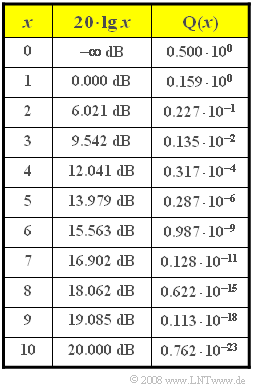Exercise 1.08Z: BPSK Error Probability
We assume the optimal baseband transmission system for binary signals with
- bipolar amplitude coefficients $a_{\nu} \in \{–1, +1\}$,
- rectangular transmitted signal with signal values $\pm s_{0}$ and bit duration $T_{\rm B}$,
- AWGN noise with noise power density $N_{0}$,
- receiver filter according to the matched filter principle,
- decision with the optimal threshold $E = 0$.
Unless otherwise specified, you should also assume the following numerical values:
- $$ s_0 = 4\,{\rm V},\hspace{0.2cm} T_{\rm B} = 1\,{\rm ns},\hspace{0.2cm}N_0 = 2 \cdot 10^{-9}\, {\rm V^2/Hz} \hspace{0.05cm}.$$
The bit error probability of this "baseband system" has already been given in the chapter "Error Probability for Baseband Transmission" $($Index: $\rm BB)$:
- $$p_{\rm BB} = {\rm Q}\left ( \frac{s_0}{\sigma_d } \right )\hspace{0.2cm}{\rm with}\hspace{0.2cm}\sigma_d = \sqrt{\frac{N_0}{2 \cdot T_{\rm B}}}.$$
Here, $\sigma_{d}$ denotes the noise rms value at the decision device and ${\rm Q}(x)$ denotes the complementary Gaussian error function, which is given here in tabular form. This error probability can also be expressed in the form
- $$p_{\rm BB} = {\rm Q}\left ( \sqrt{{2 \cdot E_{\rm B}}/{N_0 }} \hspace{0.1cm}\right ),$$
where $E_{\rm B}$ denotes "energy per bit."
The error probability of a comparable transmission system with "Binary Phase Shift Keying" is $($Index: $\rm BPSK)$:
- $$p_{\rm BPSK} = {\rm Q}\left ( {s_0}/{\sigma_d } \right )\hspace{0.2cm}{\rm with}\hspace{0.2cm}\sigma_d = \sqrt{{N_0}/{T_{\rm B}}}.$$
Notes:
- The exercise belongs to the chapter "Linear Digital Modulation - Coherent Demodulation".
- Reference is also made to the chapter "Error Probability for Baseband Transmission".
- You can check the results with the HTML5/JavaScript applet "Complementary Gaussian Error Functions".
- Since the signal value $s_{0}$ is specified here in "volts" and no specification is made for the reference resistance, $E_{\rm B}$ has the unit "$\rm V^{2}/Hz$".
Questions
Solution
- $$\sigma_d = \sqrt{\frac{N_0}{2 \cdot T_{\rm B}}}= \sqrt{\frac{2 \cdot 10^{-9}\,{\rm V^2/Hz}}{2 \cdot 1\,{\rm ns}}}= 1\,{\rm V}\hspace{0.3cm}\Rightarrow \hspace{0.3cm}p_{\rm BB} = {\rm Q}\left ({s_0}/{\sigma_d } \right )= {\rm Q}(4)= 0.317 \cdot 10^{-4}\hspace{0.1cm}\underline {= 0.00317 \%}.$$
(2) For the baseband system:
- $$E_{\rm B} = s_0^2 \cdot T_{\rm B}= (4\,{\rm V})^2 \cdot 10^{-9}\,{\rm s}\hspace{0.1cm}\underline {= 1.6 \cdot 10^{-8}\,{\rm V^2s}}.$$
- Of course, the additional given equation gives the exact same error probability:
- $$p_{\rm BB} = {\rm Q}\left ( \sqrt{\frac{2 \cdot E_{\rm B}}{N_0 }} \hspace{0.1cm}\right ) = {\rm Q}\left ( \sqrt{\frac{2 \cdot 16 \cdot 10^{-9}\,{\rm V^2s}}{2 \cdot 10^{-9}\, {\rm V^2/Hz} }} \hspace{0.1cm}\right ) = {\rm Q}(4)= 0.317 \cdot 10^{-4}.$$
- A comparison with question (4) of "Exercise 1.8" shows that $E_{\rm B}/N_{0} = 8$ is not (exactly) equal to $10 \cdot \lg E_{\rm B}/N_{0} = 9 \ \rm dB$.
- In the first case $p_{\rm BB} = 0.317 \cdot 10^{–4}$ is obtained, in the second $p_{\rm BB} = 0.336 \cdot 10^{-4}$.
(3) At half the transmission amplitude $s_{0} = 2 \ \rm V$, the energy per bit decreases to a quarter and the following equations apply:
- $$p_{\rm BB} = {\rm Q}\left ( \frac{s_0}{\sigma_d } \right )= {\rm Q}\left ( \frac{2\,{\rm V}}{1\,{\rm V}} \right )\hspace{0.1cm}\underline {= {\rm Q}(2)= 2.27 \%},$$
- $$p_{\rm BB} = {\rm Q}\left ( \sqrt{\frac{2 \cdot E_{\rm B}}{N_0 }} \hspace{0.1cm}\right ) = {\rm Q}\left ( \sqrt{\frac{2 \cdot 4 \cdot 10^{-9}\,{\rm V^2s}}{2 \cdot 10^{-9}\, {\rm V^2/Hz} }} \hspace{0.1cm}\right ) = {\rm Q}(2)= 2.27 \%.$$
(4) Considering only half the energy $E_{\rm B} = s^{2}_{0} \cdot T_{\rm B}/2$, we obtain with $\sigma^{2}_{d} = N_{0}/T_{\rm B}$ and
- $$p_{\rm BPSK} = {\rm Q}\left ( {s_0}/{\sigma_d } \right )= {\rm Q}\left ( \sqrt{{s_0^2 \cdot T_{\rm B}}/{N_0 }} \hspace{0.1cm}\right ) = {\rm Q}\left ( \sqrt{{2 \cdot E_{\rm B}}/{N_0 }}\hspace{0.1cm}\right )$$
the exact same result as for the optimal baseband system ⇒ solution 2.
(5) Of course, this also gives the exact same results as for the baseband transmission:
- $${ E_{\rm B}}/{N_0 }= 8{\rm :} \hspace{0.2cm}p_{\rm BPSK} = {\rm Q}(\sqrt{16}) = {\rm Q}(4)\hspace{0.1cm}\underline {= 0.00317 \%},$$
- $${ E_{\rm B}}/{N_0 }= 2{\rm :} \hspace{0.2cm}p_{\rm BPSK} = {\rm Q}(\sqrt{4}) = {\rm Q}(2) \hspace{0.1cm}\underline {= 2.27 \%}.$$
